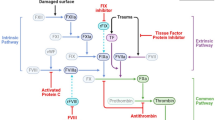Abstract
Glutaraldehyde hemoglobin polymerization gives too many high polymers, resulting in a too viscous solution. We describe here an alternate method leading to superior results, as compared to the classical one. This method includes a molecular fractionation step using a tangential flow ultrafiltration that secondarily lowers the unpolymerized tetramer’s content of a mildly polymerized, pyridoxylated hemoglobin solution (Pyr-Poly Hb). This leads to an adequately polymerized product with a lesser high polymer content, implying a lower viscosity. We thus obtain a pyridoxylated, polymerized molecular fractionated solution presenting suitable features as a blood substitute: A 7.5 g% hemoglobin 2 g% albumin solution had a 16% unpolymerized tetramer’s ratio, a 1.8 mPas viscosity, a P50 of 2.8 kPa, a Hill coefficient of 2.1, a binding coefficient of 1.3 mL/g, a colloid osmotic pressure of 2.4 kPa, and a methemoglobin concentration of 3% Male Sprague-Dawley rats undergoing an isovolumic blood exchange with this Pyr-Poly Hb solution, down to a 2% hematocrit, present a mean survival time of 20 h.
Similar content being viewed by others
References
Dudziak, R., and Bonhard, K. (1980),Anaesthesist 29, 181.
DeVenuto, F., and Zegna, A. (1982),J. Surg. Res. 34, 205.
Kothe, N., Eichentopf, B., and Bonhard, K., (1985)Surg. Gynecol. Obstet. 161, 563.
Benesch, R. E., Benesch, R., Renthal, R. D., and Maeda, N. (1972),Biochemistry 19, 3576.
Kaplan, J. C. (1965),Rev. Fr. Etudes Clin. et Biol. 10, 856.
Duvelleroy, M. A., Buckles, R. G., Rosenkaimer, S., Tung, C., and Laver, M. B. (1970),J. Appl. Physiol. 28, 227.
Teisseire, B., Teisseire, L., Lautier, A., Herigault, R., and Laurent, D. (1975),Bull. Physiopathol. Resp. 11, 837–851.
DeVenuto, F., and Zegna, A. (1983), inAdvances in Blood Substitute Research, Bolin and Geyer, eds., Alan Liss, New York, NY, pp. 29–39.
Sehgal, L. R., Rosen, A. L., Gould, S. A., Sehgal, H. L., and Moss, G. S. (1983).Transfusion 23, 158.
Keipert, P. E., and Chang, T. M. S. (1984),Applied Biochem. Biotech. 19, 133.
Monsan, P., Puzo, G., and Mazarguil, H. (1975),Biochimie 57, 1281.
Author information
Authors and Affiliations
Rights and permissions
About this article
Cite this article
Clerc, Y., Dubos, M., Bihoreau, N. et al. Pyridoxylated Polymerized Hemoglobin Solution Processing. Appl Biochem Biotechnol 14, 241–251 (1987). https://doi.org/10.1007/BF02800311
Received:
Accepted:
Issue Date:
DOI: https://doi.org/10.1007/BF02800311




